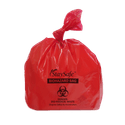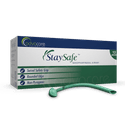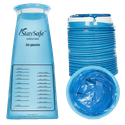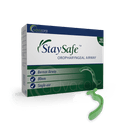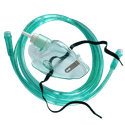Biohazard Bag
Material
Type
Thickness
Color
Size
Packaging
What is a Biohazard Bag?
A Biohazard Bag is a specialized bag that has been designed to safely contain and dispose of potentially infectious or biohazardous substances. They are used in healthcare settings, laboratories, and other many other industries where there is a risk of exposure to biological, chemical, or infectious substances.
These types of bags are also known as infectious waste bags or biomedical waste bags. They are color-coded with red or yellow and prominently display biohazard symbols in order to clearly indicate the presence of hazardous materials.
In order to meet specific requirements for the level of risk, hazardous waste bags are produced in different series, including EconoSafe, XtraSafe, and UltraSafe. They are available in a wide range of sizes, ranging from 40x30cm to 105x60cm, and can be customized between 7 different styles, including flat open, T-shirt, self-adhesive, on-roll, drawstring, zip lock, and star-bottom.
AdvaCare Pharma is a manufacturer and global distributor of Biohazard Bags. This product and our entire line of medical disposables have been produced in ISO/CE-certified facilities in India, China, and the USA. Each facility is regularly audited to ensure they are compliant with healthcare standards for quality and safety.
Product Specifications
Material
Type
EconoSafe Series (LDPE)
EconoSafe series (LDPE) biohazard bags are made of low-density polyethylene, which is a type of plastic known for its flexibility and toughness. LDPE may not be as strong or durable as other types of plastic, such as HDPE or PP, and may not be suitable for all types of medical waste.
The econoSafe series of biohazard bags offer an economical option for basic biohazard waste disposal. These bags are suitable for low-risk waste and provide adequate containment.
XtraSafe Series (HDPE)
XtraSafe Series (HDPE) biohazard bags are made of high-density polyethylene, which is a type of plastic known for its strength, durability, and resistance to chemicals. It is a reliable and cost-effective option, yet strong enough to contain potentially infectious medical waste.
The XtraSafe series of biohazard bags provide enhanced strength and durability. These bags are ideal for medium-risk waste and offer increased tear and puncture resistance, minimizing the risk of leaks or spills.
UltraSafe Series (PP)
UltraSafe Series (PP) biohazard bags are made of polypropylene, which is a synthetic thermoplastic polymer that is known for its strength, durability, and resistance to chemicals. It is a lightweight material that is easy to handle and dispose of, making it ideal for biohazard bags. These biohazard bags are designed to be leak-proof and puncture-resistant, to prevent the contents from spilling out and potentially contaminating the environment.
The UltraSafe series of biohazard bags offer the highest level of strength and integrity. These bags are suitable for high-risk waste and provide excellent resistance to chemicals and extreme temperatures.
Flat Open
Flat Open biohazard bags are designed with a flat bottom and an open top. This style of closure is typically used for easy and quick disposal of biohazardous waste.
Flat open biohazard bags can be conveniently placed on a surface or in a bin for waste collection. This style of biohazard bags provides a safe and hygienic solution for the containment and disposal of biohazardous materials.

T-Shirt
T-Shirt style biohazard bags are named after their shape, as they resemble a T-shirt when laid flat. These bags have a gusseted bottom, allowing the bag to expand and provide more space for waste.
T-Shirt bags are commonly used to dispose of larger or bulkier biohazardous items, as the gusseted design can help accommodate irregularly-shaped waste.

Self-Adhesive
Self-Adhesive biohazard bags have an adhesive strip or flap that has been incorporated into their design. This feature enables easy and secure closure of the bag once it is filled with waste.
The self-adhesive closure has been included to help prevent any accidental exposure or leakage during transportation or disposal.
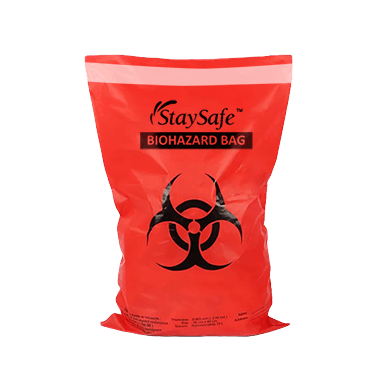
On-Roll
On-Roll biohazard bags are typically connected in a roll format, allowing for convenient and efficient dispensing. These bags are perforated between each bag, allowing easy tear-off when needed.
On-roll bags are commonly used in healthcare settings, as they are convenient to grab a bag as required without the need for separate packaging or storage.
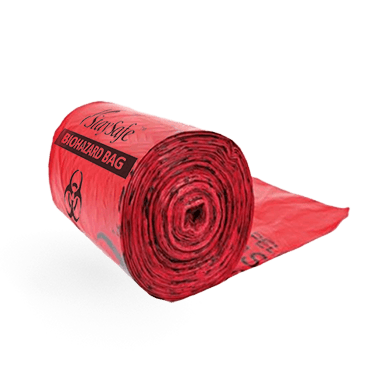
Drawstring
Drawstring biohazard bags are equipped with a drawstring closure mechanism. The built-in drawstring or cord can be pulled and tied in order to secure the contents inside the bag.
The drawstring closure style provides simplicity with added convenience while also ensuring a tight seal to minimize any potential exposure to waste.
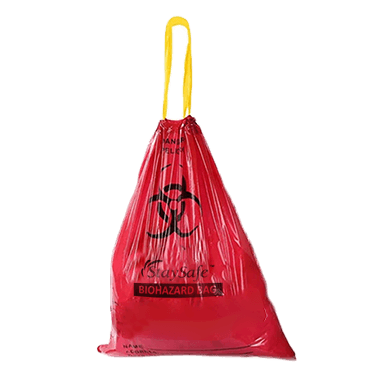
Zip Lock
Zip Lock biohazard bags incorporate a zip-lock closure mechanism, similar to resealable plastic bags. The bag has a built-in zipper track that allows for repeated opening and closing, providing ease of use and a reliable seal.
Zip lock bags are commonly used when there is a need for repeated access to the bag's contents or when additional protection against contamination is required.
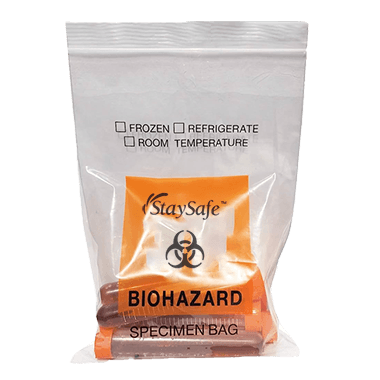
Star-Bottom
Star-Bottom biohazard bags feature a unique star-shaped seal at the bottom of the bag. This design helps to distribute the weight evenly and prevents the bag from easily tearing or leaking when filled with heavy or sharp waste items.
Star bottom bags are often preferred for their enhanced strength and reliability.

Why are we a quality Biohazard Bag manufacturer?
AdvaCare Pharma, a leading global supplier, specializes in manufacturing Biohazard Bags and a wide range of medical disposables for waste disposal. A comprehensive STED dossier accompanies each of our products, assuring our partners and distributors of consistent adherence to the highest quality standards in our medical supplies.
Leveraging our extensive industry experience, we have established a distribution network spanning 65 markets worldwide. Our business model prioritizes forging strong partnerships with our distributors, and our dedicated team offers unparalleled support throughout the entire process, from supply chain coordination and registration assistance.
Uses
What is a Biohazard Bag used for?
A Biohazard Bag is used to safely contain biohazardous waste materials, including items like contaminated gloves, dressings, or laboratory specimens. Its primary purpose is to provide a secure and hygienic means of disposing of these materials to prevent any potential spread of hazardous substances.
How is a Biohazard Bag used?
To use a Biohazard Bag, simply place the biohazardous waste materials into the bag. Once filled, the bag should then be securely sealed so that there is no leakage or contamination. Follow handling procedures and wear appropriate personal protective equipment (PPE) when dealing with certain types of biohazardous waste to minimize the risk of exposure.
What are the recommendations for the storage of unused Biohazard Bags?
Unused Biohazard Bags should be stored in a designated area specifically allocated for biohazardous waste materials. Keep them in a cool, dry location away from direct sunlight and any potential heat sources.
These bags should be stored separately from other types of waste materials to keep their integrity and prevent unintentional contamination.
How should Biohazard Bags be disposed of?
Adequate disposal of Biohazard Bags is required to prevent the potential spread of infectious agents. Used biohazard bags should be disposed of in accordance with local regulations and institutional guidelines for biohazardous waste management.
Typically, this involves sealing the filled biohazard bag, placing it inside another biohazard bag or a rigid container, and correctly labeling it with biohazard symbols and relevant waste management information. The exact disposal process may vary based on local guidelines, so it is advisable to follow the specific instructions provided by the relevant authorities.
How do doctors use the Biohazard Bag?
Doctors utilize Biohazard Bags primarily for the safe disposal of biohazardous waste generated during medical procedures or patient care. They place items such as used gloves, dressings, or any materials contaminated with potentially infectious agents into the bag. The bag is then securely sealed to confirm containment.
Doctors are trained to follow established protocols and safety guidelines when handling biohazardous waste to minimize the risk of infection and protect both healthcare workers and the environment.
FAQs
What is the difference between the different series of Biohazard Bags?
The different types of biohazard bags vary based on the materials they are made from and their specific characteristics for regulatory compliance. The EconoSafe Series is made of LDPE (low-density polyethylene), which provides a cost-effective option for biohazard waste disposal. The XtraSafe Series is made of HDPE (high-density polyethylene) and offers enhanced strength and durability, making it suitable for heavy or sharp waste items. The UltraSafe Series is made of PP (polypropylene), which offers excellent chemical resistance and durability and is often used for highly hazardous waste materials.
What types of waste should be placed in Biohazard Bags?
Biohazard bags are intended for the various types of infectious waste, such as used medical supplies, contaminated materials, laboratory specimens, cultures, or any other waste that may pose a risk of infection to humans or the environment.
How do Biohazard Bags differ from regular trash bags?
Biohazard bags are specifically designed to meet specific standards for the safe handling and disposal of potentially infectious waste. They are usually made of thicker, puncture-resistant material and are labeled with biohazard symbols or color-coded to indicate the presence of hazardous materials.
Is it possible to sell your Biohazard Bags to hospitals and clinics?
Yes, our medical devices are suitable for distribution in various healthcare settings, including laboratories, hospitals, clinics, pharmacies, and other medical institutions. With our streamlined distributor verification process, getting started is simple. Reach out to our International Sales Department to learn more about distributing our medical devices in your market.
What style of closure is recommended for the Biohazard Bags?
When choosing a closure style, it is important to consider factors like the containment level required, the disposal regulations in the region or area, the type of waste (e.g., sharp items, liquid waste), and any specific guidelines provided by healthcare or waste management authorities.
References
Viruses Demonstrate Selective Survival During Simulated Anaerobic Digestion of Plant Biomass
This study discusses the survival of viruses in biohazardous waste during anaerobic digestion, indicating the importance of proper biohazard bag usage in managing such waste. This research can be insightful for understanding the risks associated with biohazard waste disposal and the effectiveness of different waste management practices.

You might be interested in...
Why AdvaCare Pharma?
As an industry leader, we are aware of our responsibility to provide affordable and sustainable solutions to improve healthcare worldwide.

